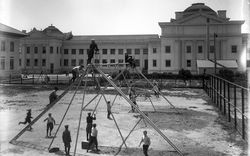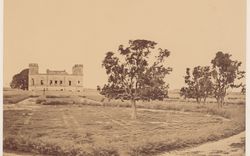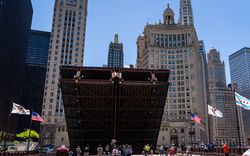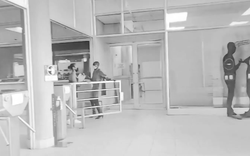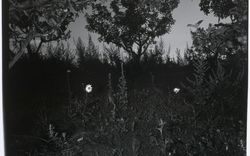The River and the Risk
Leonie Hartung asks what it means to legally protect a (river-)landscape when the concept of landscape itself is no longer tangible
Reconstruction of the Ahr Valley
In July 2021, warm, humid air from the Mediterranean, and constant, heavy rainfall led to extreme flow rates of the Ahr river in Rhineland-Palatinate.1 These weather conditions combined with existing soil moisture, a constricted riverbed with paved banks and dense residential development, and a high level of sealing around the river resulted in the severe flood disaster in the Ahr, which destroyed over nine thousand houses, as well as roads, infrastructure, and electricity supply.2
There have always been floods in the Ahr Valley, but extreme weather conditions caused by the climate crisis are making such events increasingly likely. Three years after the flood, most of the houses have been rebuilt but the shaping of the riverbed is progressing slowly. The Valley now characterized by countless excavators, and construction noise, is often referred to as “Germany’s largest construction site.”3
The flood represents a turning point in dealing with the river and its landscape, in which new plans, decisions, and negotiations can be made. The area is to be transformed into a model region in which climate protection and flood protection go hand in hand. Elaborate supra-local flood protection concepts are being developed to prevent another disaster of this magnitude.4 In a sense, the Ahr Valley could serve as a precedent for what it means to reshape life at and with the river. At the same time, the complex legal protection of the landscape is impacting the reconstruction.5 Large areas of the river and valley landscape are under landscape protection, the “Rhine-Ahr-Eifel” protected area, in accordance with §§18 and 30, Section 3 of the Rhineland-Palatinate State Nature Conservation Act (LPflG).6 But what is the specific object of protection and what does the term “landscape” mean here? And how does this protection relate to a landscape that is exposed to an increased risk of floods? What kind of (river-) landscape is being rebuilt here and for whom or what is it keeping “safe” and “protected”?
-
In July 2021, over 100 mm of rainfall in one day led to flow rates of 1200 m3/s of the river Ahr. Maya Kothe: “Versöhnung mit der Ahr – Fluss und Freiraum rücken ins Zentrum”, Stadt+Grün, accessed 31 May 2024, https://stadtundgruen.de/artikel/versoehnung-mit-der-ahr-fluss-19604. ↩
-
“Landesamt für Umwelt Rheinland-Pfalz, Bericht. Hochwasser im Juni 2021, 2022,” accessed 31 May 2024, https://www.hochwasser.rlp.de/static/shared/documents/Hochwasser_im_Juli2021.pdf. ↩
-
Cornelia Weigand, Speech, Inauguration of a new bridge (“Weinbergbrücke”), Dernau, 22 May 2024. ↩
-
Supported by the ‘KAHR’ (Climate Adaptation, Floods and Resilience) project, among others, in which many different stakeholders are involved. ↩
-
In Germany, there are various legal formats for protecting nature or the landscape. Landscape protection areas are particularly interesting because they are larger in scale, offer weaker protection than nature protection areas and include settlements – in other words, they provide a concrete legal framework for human activity within a culturally representative landscape that is considered worthy of protection. Within the actual legal practice, however, settlement areas are mostly excluded from the scope of application. ↩
-
“Verordnung über das Landschaftsschutzgebiet “Rhein-Ahr-Eifel””, accessed 31 May 2024, https://naturschutz.rlp.de/Dokumente/rvo/nsg_archiv/600104.htm. ↩
Beauty, uniqueness, and diversity
Within the legal text of the landscape conservation area, one finds a human-centred, romantic-aesthetic interpretation of the landscape that has fallen out of time. All points refer to the human perception and usability of a landscape. According to paragraph §3, one of the key protective purposes of the “Rhine-Ahr-Eifel” area is “the preservation and maintenance of the character and beauty of the landscape in the volcanic East Eifel region with the Ahr and Rhine Valleys.” The term “beauty of the landscape” allows conclusions to be drawn about a distanced, conventional, and visually influenced concept of landscape. It is an Unbestimmter Rechtsbegriff (undefined legal term)—a term whose interpretation is subjective and difficult to grasp. The history of nature conservation in Germany began not far from the Ahr Valley at the Drachenfels, when it was partially eroded by quarry work. Together with the rediscovery of the Nibelungenlied and an emerging patriotism, the Siebengebirge was charged with significance and the “Verschönerungsverein für das Siebengebirge” (Beautification Association for the Siebengebirge) was founded in 1869 with the aim of closing down the quarry.1 Although the concern was partly about the extraction of resources, the motivation to protect the landscape arose—as the name suggests—for aesthetic reasons. These aesthetic and patriotic sentiments projected on the landscape continue today through the controversial concept of “Heimat.” In a time of growing right-wing populism, the concept of beauty and “Heimat” are repeatedly instrumentalized by the AfD.2 In the case of the Rheinhardswald “fairytale forest,” these concepts have been used in the debate about whether wind turbines disturb the landscape.3
“Anyone who considers forested areas with a large number of seriously impaired trees as landscape, who hikes across monotonous, agricultural acreage and considers it part of the landscape, will find it increasingly difficult to tune out the knowledge of the endangerment of natural spaces. Even the clouds are no longer the floating constructs in the celestial realm arching over the pictorial landscape that they used to be.”4
But what does it mean to legally protect a landscape if the concept of landscape itself is no longer tangible? Because, as Ludwig Fischer writes here, the traditional concept of landscape is no longer relevant—because the distance and abstraction with which landscapes were viewed and constructed, idealized and romanticized, became the basis for the exploitation and appropriation of nature. Fischer argues here for a new concept of landscape, in which humans see themselves as an integral part of a landscape. He calls this new concept and practice between human and the environment “alliance space.” However, there is no room for such a new understanding in the law itself.
-
Stiftung Naturschutzgeschichte: Drachenfels, accessed 31 May 2024, https://www.naturschutzgeschichte.de/stiftung-historischer-ort.html#Drachenfels. ↩
-
AfD (Alternative für Deutschland or Alternative for Germany) is a far-right populist political party in Germany. ↩
-
“AfD will Wald in Hessen schützen”, taz online, accessed 26 May, 2024, https://taz.de/Initiative-kritisiert-falsche-Fakten/!5704334/. ↩
-
Ludwig Fischer: “A Farewell to the Concept of Landscape?”, in: Girot, Kirchengast (Eds.): Landscape Analogue, Berlin 2022. ↩
In contrast to the soft concept of “beauty”, the two terms “individual character” and “diversity” of the landscape are somewhat easier to define, as they are more concerned with the characteristics of a cultural landscape, i.e. specific morphological and characteristic features of the landscape together with its anthropogenic character. This includes, for example, the “meandering course of the river with numerous narrow passages […]; old settlement landscape, terraced vineyards in the river valley with retaining and dry stone walls (partly on steep slopes), historic winegrowing villages [… ] and path connections, numerous landscape-defining buildings […], viaducts and tunnels, mills, historic town centres […]”.1
But what kind of cultural landscape is being protected and how does this relate to the flood? The rationalized steep-slope viticulture in the valley, which strongly characterizes the landscape, also contributed to the strength of the 2021 flood, as the water flowed directly down through the vine rows towards the river. The same applies to “landscape-defining structures” such as historic bridges, where alluvial material accumulated and contributed to the intensity of the flood. At the same time, the course of the river has been straightened in many places over time and the banks paved, so that there are hardly any floodplain meadows and forests left.2 The protected anthropogenic landscape contributes to a higher flood risk. This is not only about the risk of destruction of the anthropogenic landscape and a safety risk for local residents, but also about the protection of non-human life. Improved flood protection improves biodiversity. So, what is prioritized—flood protection and species conservation or the preservation of an established cultural landscape?
Tourism and recreational value
Another of the key protective purposes of the “Rhine-Ahr-Eifel” area is “the sustainable safeguarding of the recreational value.” This undefined legal term of “recreational value” can also be deconstructed. Here too, the focus is on an extremely human-centred view. The landscape is only considered in terms of its usability for people, namely for the benefit of their own recreation. The Ahr has a long history of tourism, preceded and stimulated by the Rhine Romanticism, which later also included the Ahr.1 Romantic landscape paintings circulated here, such as the engravings by Jean Nicolas Ponsart, who also published the first hiking map of the Ahr Valley. Around the same time, various healing springs were discovered in the area, which boosted spa tourism in the region. For this purpose, various spa facilities and riverside parks were planned in the lower valley of the river, which were only made possible by the narrowing of the riverbed. In this case, human recreation obstructs a resilient, flood-resistant landscape. But serious recovery within a landscape that we know is vulnerable and hazardous no longer seems possible. The same applies to wine tourism of the area, which is rooted primarily in picturesque views of the valley—the landscape here is once again distanced and abstracted. In the moment the landscape changes drastically due to heat or constant rain, this is no longer possible. If the definition of recreation was extended to non-human life forms, an expanded riverbed and biodiversity would become key elements to protect.
-
Jürgen Haffke: 200 Jahre Ahrtal-Tourismus Von der “niederrheinischen Schweiz” “zum Paradies für Genießer”, accessed 31 May 2024, https://www.rheinische-geschichte.lvr.de/Epochen-und-Themen/Themen/200-jahre-ahrtal-tourismus-von-der-niederrheinischen-schweiz-zum-paradies-fuer-geniesser/DE-2086/lido/57d128fd1a8294.52801302. ↩
Prohibitions
In order to achieve the objectives of the “Rhine-Ahr-Eifel” area, the specific planning practice is regulated by the prohibitions. If a construction project is planned within the protected area, it is often possible to obtain an exception to the prohibitions (if this does not run counter to the purposes of protection). Typically, the lengthy process of an environmental impact assessment must be carried out for any potential development located within a protected area. As a result of the flood in the Ahr Valley, the German government introduced the law § 246c in the Building Code (BauGB) for a resilient and simpler reconstruction1. Among other things, this law enables an administrative-free and accelerated designation of building land, as well as flood-adapted reconstruction without changes to the development plan. Furthermore, the town of Bad Neuenahr-Ahrweiler, for example, has issued a statute in accordance with § 25 Section 1, No. 2 of the Building Code (BauGB), which grants the town a right of first refusal for land close to the riverbank, both for new areas to be built on and for gaining floodplains along the river.2 Despite this legal relief, many people in the Ahr Valley have rebuilt their houses in the same place directly on the riverbank, in the newly designated flood zone: partly due to a lack of financial means, lack of insurance payments, lack of time, or other reasons. Many are also relying on the flood protection that is now being built such as larger retention basins, which will still take several years to complete.
-
§ 246c Abweichungen vom Baugesetzbuch für den Wiederaufbau im Katastrophenfall; Verordnungsermächtigung, accessed 31 May 2024, https://www.gesetze-im-internet.de/bbaug/__246c.html. ↩
-
Satzung der Stadt Bad Neuenahr-Ahrweiler über ein besonderes Vorkaufsrecht gem. § 25 Abs. 1 Nr. 2 Baugesetzbuch (BauGB) mit der Bezeichnung, accessed 31 May 2024, https://www.bad-neuenahr-ahrweiler.de/fileadmin/redaktion/stadt/ortsrecht/Vorkaufsrechtsatzung_HH__etc_gez_2021_08_25.pdf. ↩
Planning with risk
The landscape protection area is only a small part of a complex planning and legal structure, alongside other protected areas such as FFH-areas (Flora-Fauna-Habitats), bird sanctuaries, and nature protection areas, not to mention various other building regulations.1 However, this protection regulation for large, continuous landscapes with its settlement areas defines particularly subjective factors as protection goals and contains outdated concepts of landscape. Could such protection be thought of in a radically different way, in the sense of an “alliance space”? How can the coexistence of people and the environment within the complex river landscape be regulated differently? How do you rebuild a landscape “safely” and which aspects of a landscape are worth protecting? Rethinking legally established systems is certainly a utopian undertaking. However, events such as the 2021 flood and the subsequent extensive reconstruction should be a moment to redefine whether to plan and live against risk or with risk, and to question common perceptions of the nature and landscape around us.
-
Bundesamt für Naturschutz, Ahrtal, accessed 31 May 2024, https://www.bfn.de/landschaftssteckbriefe/ahrtal. ↩





